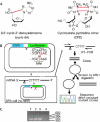Transcriptional bypass of bulky DNA lesions causes new mutant RNA transcripts in human cells
- PMID: 17363972
- PMCID: PMC1852755
- DOI: 10.1038/sj.embor.7400932
Transcriptional bypass of bulky DNA lesions causes new mutant RNA transcripts in human cells
Abstract
Here, we characterize the mutant transcripts resulting from bypass of an 8,5'-cyclo-2'-deoxyadenosine (cyclo-dA) or cyclobutane pyrimidine dimer (CPD) by human RNA polymerase II (Pol II) in vivo. With the cyclo-dA lesion, we observed two new types of mutant transcripts. In the first type, the polymerase inserted uridine opposite the lesion and then misincorporated adenosine opposite the template deoxyadenosine downstream (5') of the lesion. The second type contained deletions of 7, 13 or 21 nucleotides (nt) after uridine incorporation opposite the lesion. The frequency of the different types of transcript from the cyclo-dA lesion in mutant human cell lines suggests that the Cockayne syndrome B protein affects the probability of deletion transcript formation. With the CPD-containing construct, we also detected rare transcripts containing 12 nt deletions. These results indicate that RNA pol II in living human cells can bypass helix-distorting DNA lesions that are substrates for nucleotide excision repair, resulting in transcriptional mutagenesis.
Figures




Similar articles
-
Mechanism of RNA polymerase II bypass of oxidative cyclopurine DNA lesions.Proc Natl Acad Sci U S A. 2015 Feb 3;112(5):E410-9. doi: 10.1073/pnas.1415186112. Epub 2015 Jan 20. Proc Natl Acad Sci U S A. 2015. PMID: 25605892 Free PMC article.
-
CPD damage recognition by transcribing RNA polymerase II.Science. 2007 Feb 9;315(5813):859-62. doi: 10.1126/science.1135400. Science. 2007. PMID: 17290000
-
Transcript cleavage by RNA polymerase II arrested by a cyclobutane pyrimidine dimer in the DNA template.Proc Natl Acad Sci U S A. 1994 Aug 30;91(18):8502-6. doi: 10.1073/pnas.91.18.8502. Proc Natl Acad Sci U S A. 1994. PMID: 8078911 Free PMC article.
-
DNA photodamage recognition by RNA polymerase II.FEBS Lett. 2007 Jun 19;581(15):2757-60. doi: 10.1016/j.febslet.2007.05.014. Epub 2007 May 11. FEBS Lett. 2007. PMID: 17521634 Review.
-
Molecular basis of transcriptional fidelity and DNA lesion-induced transcriptional mutagenesis.DNA Repair (Amst). 2014 Jul;19:71-83. doi: 10.1016/j.dnarep.2014.03.024. Epub 2014 Apr 21. DNA Repair (Amst). 2014. PMID: 24767259 Free PMC article. Review.
Cited by
-
Mitochondrial DNA damage and its consequences for mitochondrial gene expression.Biochim Biophys Acta. 2012 Sep-Oct;1819(9-10):979-91. doi: 10.1016/j.bbagrm.2012.06.002. Epub 2012 Jun 19. Biochim Biophys Acta. 2012. PMID: 22728831 Free PMC article. Review.
-
Induction of 8,5'-cyclo-2'-deoxyadenosine and 8,5'-cyclo-2'-deoxyguanosine in isolated DNA by Fenton-type reagents.Chem Res Toxicol. 2013 Sep 16;26(9):1361-6. doi: 10.1021/tx400221w. Epub 2013 Sep 4. Chem Res Toxicol. 2013. PMID: 23961697 Free PMC article.
-
5',8-Cyclopurine Lesions in DNA Damage: Chemical, Analytical, Biological, and Diagnostic Significance.Cells. 2019 May 28;8(6):513. doi: 10.3390/cells8060513. Cells. 2019. PMID: 31141888 Free PMC article. Review.
-
Endogenous formation and repair of oxidatively induced G[8-5 m]T intrastrand cross-link lesion.Nucleic Acids Res. 2012 Aug;40(15):7368-74. doi: 10.1093/nar/gks357. Epub 2012 May 11. Nucleic Acids Res. 2012. PMID: 22581771 Free PMC article.
-
8-Oxo-7,8-dihydroguanine: links to gene expression, aging, and defense against oxidative stress.Free Radic Biol Med. 2010 Aug 15;49(4):587-96. doi: 10.1016/j.freeradbiomed.2010.05.008. Epub 2010 May 17. Free Radic Biol Med. 2010. PMID: 20483371 Free PMC article.
References
-
- Andressoo JO, Hoeijmakers JH (2005) Transcription-coupled repair and premature ageing. Mutat Res 577: 179–194 - PubMed
-
- Brooks PJ et al. (2000) The oxidative DNA lesion 8,5′-(S)-cyclo-2′-deoxyadenosine is repaired by the nucleotide excision repair pathway and blocks gene expression in mammalian cells. J Biol Chem 275: 22355–22362 - PubMed
-
- Brueckner F, Hennecke U, Carell T, Cramer P (2007) CPD damage recognition by transcribing RNA polymerase II. Science 315: 859–862 - PubMed
MeSH terms
Substances
Grants and funding
LinkOut - more resources
Full Text Sources
Other Literature Sources
Research Materials

